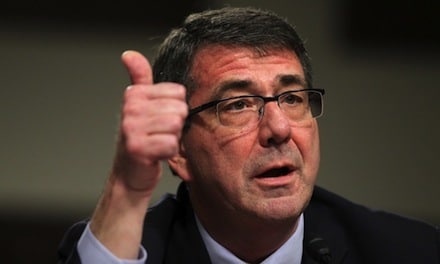
US Defense Secretary Ashton Carter has outlined in some detail the purpose of his mission to India next week. Principally he hopes to discuss arms deals and explore the parameters of co-production of weapons feasible under American laws prohibiting technology transfer. His focus is on the “potential production of fighter aircraft.”
American diplomacy makes it a point to envelop arms deals with rhetoric couched in the idiom of “shared values” – even when the US wraps up highly lucrative multi-billion dollar deals with countries such as Saudi Arabia. Thus, it comes as no surprise that in an address at the Council of Foreign Relations in New York on Friday, entitled “America’s Growing Security Network in the Asia-Pacific,” Carter endeavoured to habitate the upcoming “exciting new projects” with India within an proposed regional security architecture under US leadership.
From the US perspective, the growing “interoperability” involving the two militaries serves the purpose of anchoring India as a key non-NATO ally, which of course demands a fundamental shift by India away from its non-aligned policies and its aversion to military blocs. Carter saw the US-Indian co-production of weapons under the “Make in India,” the “burgeoning” military exercises as well as various other activities of military-to-military cooperation as ensuring the “interoperability” of the armed forces.
Carter outlined in his speech the US blueprint for creating a new alliance system in Asia that can tackle the challenges posed by the rise of China. Washington assigns an important role in it for India. Carter saw a “strategic handshake” already existing between the US and India, with Washington’s rebalance in Asia poised to “reach west” and New Delhi’s Act East “reaching east… that will bring it farther into the Indian and Pacific Oceans.”
Carter fleshed out a road map that involves the US “augmenting” its traditional alliances in Asia-Pacific (Japan, South Korea, Australia and Singapore) by coupling them with bilateral relationships (India, Philippines) and any other trilateral and multilateral arrangements existing at present.
The US will be “weaving these partnerships together to more effectively bolster American and regional security.” The objective is to create a “network” of countries with “shared values, habits of cooperation, and compatible and complementary capabilities” under American supervision, which will expand the strategic reach of the participating countries, enable them to pool their resources to share the security burden, and, thereby, “help ensure the peace and stability in the region for years to come.”
Carter singled out in two trilateral mechanisms in which India is involved – the “burgeoning” US-Japan-partnership (which has evolved from a mere strategic dialogue to “real, practical security cooperation that spans the entire region from the [Indian] subcontinent right around to East Asia”) and, second, the nascent Japan-Australia-India format.
The above two mechanisms involving India will be part of the US-led “network” by actively developing their “interconnected security relationships.” Thereby, Carter said, “we (US) are helping create an interconnected regional architecture – from one end of the region to another.”
This proposed “network” forms one vector of an integrated approach to “operationalize” the US rebalance in Asia, the two other vectors being, the Trans-Pacific Partnership trade pact and, the military vector of enhanced American force posture “throughout this vitally important region to continue playing a pivotal role from the sea, in the air, and under the water, as well as to make our posture more geographically distributed, operationally resilient, and politically sustainable.”
The stunning part of Carter’s presentation was that he took it for granted that India is already on board the US-sponsored “network.” He cited the Joint Vision Statement of January 2014 by President Barack Obama and Prime Minister Narendra Modi as confirmation of the US-Indian “strategic handshake.”
The salience of Carter’s speech is that Washington expects India to make a fundamental shift away from its strategic autonomy and its aversion to military blocs. Carter saw the US-Indian defence cooperation under the “Make in India,” the “burgeoning” military exercises and other activities ensuring the “interoperability” of the armed forces as ultimately providing a crucial underpinning for the US’ alliance system in Asia.
Call this proposed alliance system “network” or by any other name, what is on the anvil is an “Asian NATO” to contain China (and Russia).
In fact, at the very outset of his speech, Carter spelt out in black and white the “five evolving, major immediate challenges” to the US’ security interests. They are, ad seriatim:
Strategic congruence with a superpower with global interests is indivisible. Put differently, the US intends to break up India’s strategic partnership with Russia and to continue to interfere in Indian-Iranian relations, apart from inserting itself into the Sino-Indian bilateral discourses.
US motivations are understandable. The rebalance is urgently in need to gravitas. Indeed, Carter admitted the Pentagon’s corporate interests insofar as the rebalance calls for a phenomenal increase in the US defence allocation.
But, what is there in such an alliance system for India? That needs a separate analysis. The text of Carter’s speech is here.
Reprinted with permission from Indian Punchline.

